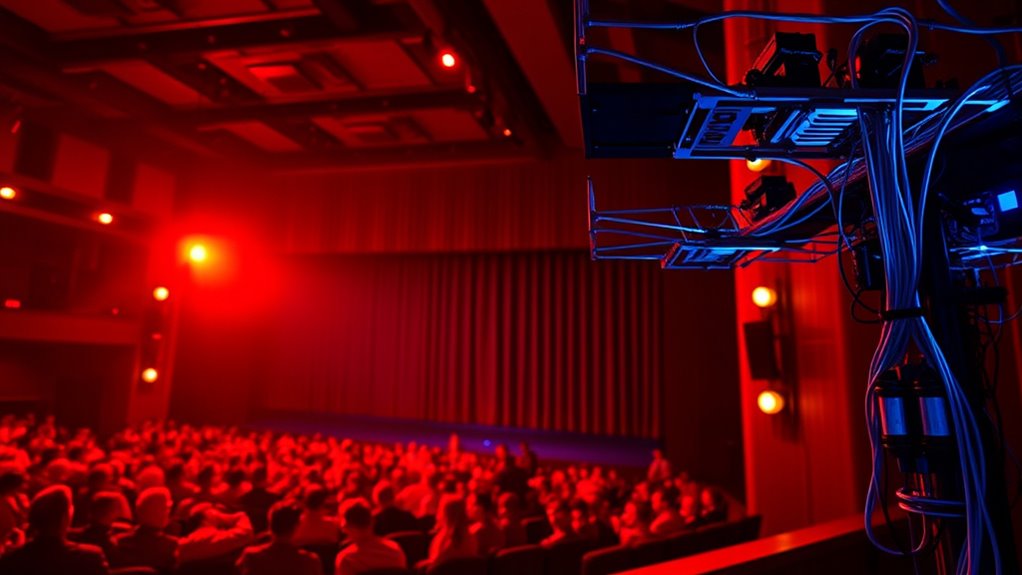Infrared systems in theaters provide secure, interference-resistant audio, thanks to their narrow beams and line-of-sight setup. RF systems offer more flexibility, larger coverage, and easier installation but can be vulnerable to interference from Wi-Fi or Bluetooth. IR is ideal for controlled environments, while RF suits dynamic spaces with movement. Each system’s pros and cons impact performance differently — to learn more about choosing the right setup for your theater, keep exploring.
Key Takeaways
- IR systems offer high security and interference resistance but require a clear line of sight, limiting mobility.
- RF systems provide greater flexibility and range suitable for large or dynamic theater environments.
- IR’s susceptibility to obstructions makes it less ideal for environments with frequent movement.
- RF systems are vulnerable to interference from other wireless devices, which can affect audio quality.
- The choice depends on environment control, security needs, and whether mobility or interference resistance is prioritized.

When choosing between infrared (IR) and radio frequency (RF) systems, understanding their fundamental differences is essential. Both are popular wireless transmission options used in theaters to support assistive listening devices, but they operate quite differently and have distinct advantages and drawbacks. IR systems transmit signals through light waves, which means the signal relies on a direct line of sight between the transmitter and receiver. If anything blocks that line of sight—such as theater curtains, audience members, or equipment—you’ll experience a disrupted connection. This makes IR systems highly secure and less susceptible to signal interference from external sources. However, their dependence on a clear line of sight can be limiting in dynamic environments where movement or obstacles frequently occur.
IR systems require a clear line of sight, offering security but limiting flexibility in dynamic environments.
On the other hand, RF systems send signals via radio waves, which can penetrate walls, clothing, and other obstacles. This flexibility allows for greater mobility and ease of use, especially in larger or more complex theater setups. With RF, you don’t have to worry about maintaining a direct line of sight, making it more reliable in situations where movement or obstacles are unavoidable. Still, RF systems are more vulnerable to signal interference from other wireless devices, such as Wi-Fi networks, Bluetooth gadgets, or nearby radio transmitters. This interference can cause audio dropouts or degraded sound quality, impacting the listener’s experience. Consequently, RF systems require careful frequency management and testing to minimize disruptions. Additionally, understanding wireless signal interference is crucial for optimizing system performance.
When weighing these options, consider your specific environment. If your theater has a controlled setup with minimal obstacles and you prioritize security and interference resistance, IR might suit you better. Its narrow transmission beam also reduces the risk of signal leakage, making it a good choice for confidential or sensitive applications. But if your theater is larger, more dynamic, or involves frequent movement, RF’s greater range and flexibility could outweigh its susceptibility to interference. You should also think about the technical infrastructure available and whether you can manage potential signal disruptions in RF systems.
Ultimately, the decision hinges on balancing the need for reliable wireless transmission against the environment’s constraints. IR offers precision and security in controlled conditions, while RF provides versatility and mobility at the expense of possible interference. By understanding these core differences, you’ll be better equipped to select the system that aligns with your theater’s needs, ensuring clear, consistent audio for all your audience members.
Frequently Asked Questions
How Do Infrared and RF Systems Compare in Terms of Installation Costs?
When comparing installation costs, you’ll find that infrared systems generally have lower upfront expenses due to simpler setup and less specialized equipment. RF systems tend to be more costly because of their complex installation process and need for more extensive infrastructure. The cost comparison also depends on installation complexity, with infrared offering quicker, easier deployment, while RF might require more time and technical expertise, increasing overall costs.
Are There Specific Safety Concerns Associated With RF or Infrared Systems?
You should be aware that RF systems may pose health risks if used excessively, especially due to prolonged exposure to radiofrequency radiation, though typical use is generally safe. Infrared systems tend to have fewer safety concerns but can face interference issues from other infrared devices or environmental factors. Always follow manufacturer guidelines and safety regulations to minimize health risks and interference issues, ensuring safe operation for everyone involved.
Can Infrared and RF Systems Be Integrated With Existing Theater Audio Setups?
You can integrate infrared and RF systems with your existing theater audio setups, but expect some compatibility challenges. Technical integration requires careful planning to guarantee seamless operation between new wireless systems and your current audio equipment. You might need additional adapters or interface units. Consulting with a professional helps address potential hurdles, ensuring a smooth upgrade process so your system functions reliably without sacrificing audio quality or performance.
How Do Environmental Factors Affect the Performance of Each System?
You might wonder how environmental factors impact each system’s performance. Infrared systems are sensitive to lighting interference and struggle with direct sunlight, reducing clarity. RF systems, on the other hand, offer better weather resilience but can be affected by physical obstructions and signal interference. While both face environmental challenges, RF systems generally handle outdoor conditions better, ensuring consistent audio even in unpredictable weather.
What Are the Maintenance Requirements for Infrared Versus RF Systems?
You need to regularly check the system durability and perform calibration procedures to keep both systems functioning at their best. Infrared systems generally require less maintenance but need periodic cleaning of sensors. RF systems demand more frequent calibration due to potential signal interference. Both systems benefit from routine inspections, but RF systems might need additional troubleshooting for signal clarity, ensuring consistent performance over time.
Conclusion
As you choose between infrared and RF systems, picture yourself in a crowded theater—infrared feels like a whisper, clear yet limited, while RF is like a storm, powerful and wide-reaching. Each has its strengths and weaknesses, shaping your experience like the difference between a gentle glow and a blazing sun. Ultimately, your choice defines your theater journey—quiet intimacy or bold coverage—letting you immerse in the show, whichever path you decide to take.











